The Monster and the Saint: Religion, the Body, and the Printed Image in Colonial Peru
08 March 2023, 1:00 pm–2:00 pm

This event is free.
Event Information
Open to
- UCL staff
Availability
- Yes
Cost
- Free
Organiser
-
Emily Floyd – History of Art
Location
-
Seminar rooms 3 and 420 Gordon SquareLondonWC1H 0AWUnited Kingdom
In 1694 in Lima a monster was born. The young mother labored painfully for hours, until, at the last minute, the midwife applied a print of local Dominican holy man Juan Macías to her womb, allowing the creature to emerge. Soon after, the limeño Dominican friar-engraver Miguel Adame produced an engraved representation of this “monster,” in fact twin boys conjoined at the chest, sharing a single pair of legs but two heads and four arms. The engraving appeared in Don Pedro Peralta’s Desvios de la Naturaleza o Tratado de el Origen de los Monstros (Lima: Joseph de Contreras, y Alvarado, 1695), a text that meditates on the explanations for and implications of the birth of the conjoined twins. Given the twins ultimately emerged dead, Peralta’s central concern is for their soul(s), both the existence or nonexistence thereof and its/their potential fate after death. At first glance, the two prints appear to represent distinct ways of understanding the world and the place of the “monstrous” and sacred within it. In channeling the power of the saint, the Juan Macías print shows the holy figure’s ability to intervene in the material world. But Adame’s representation of the twins also speaks to this power; it functions not only as a scientific illustration but also as a kind of ex-voto, exhibiting the results of the first print’s miraculous intervention. Furthermore, both prints have special relevance to anxieties and aspirations about Lima’s geographic and spiritual position within the early modern Catholic world, as the region’s climate and latitude were understood to by some negatively shape and reshape the bodies of those born and living in Spain’s overseas territories. What does a consideration of the monstrous and the saintly tell us about early-seventeenth-century perspectives on the body within the colonial Andes?
About the Speaker
Emily Floyd
Lecturer in Visual Culture and Art before 1700 at UCL
Emily C. Floyd is Lecturer in Visual Culture and Art before 1700. Her research focuses on material cultures of religion in the colonial and pre-Columbian Americas, particularly religious print culture in South America. She is interested in the movement, materiality, and agency of objects. She has published on Inca metalwork, silversmith-engravers in colonial Lima, and religion and the digital humanities. She teaches on pre-Columbian and Spanish colonial art and visual culture.
Floyd is Editor and Curator at the Center for the Study of Material and Visual Cultures of Religion (MAVCOR--mavcor.yale.edu). She is the recipient of the American Catholic Historical Association's John Tracy Ellis Dissertation award and the Denver Art Museum's Alianza-Mayer Fellowship. She has also received residential fellowships from the John Carter Brown, Beinecke, and Lilly Libraries.
More about Emily Floyd Close
Close

